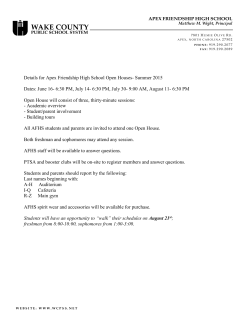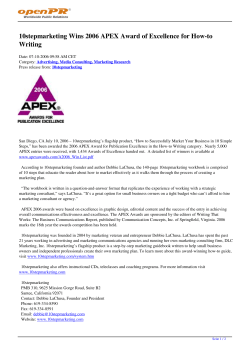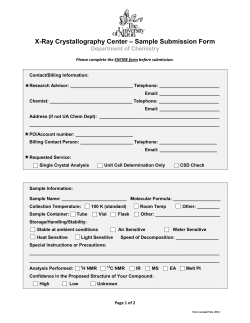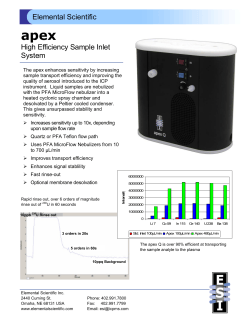
as a PDF
THE SPACE TEST PROGRAM APEX MISSION SATELLITE Frank L. Knight The Aerospace Corporation Los Angeles, CA Abstract An overview is presented of the Air Force Space Test Program's Advanced Photovoltaic And Electronic Experiments (APEX) Mission. APEX will provide spaceflight for three military experiments on the fourth flight of the Pegasus Air-Launched Vehicle in early 1993. The APEX spacecraft is Orbital Sciences Corporation's "PegaStar" integrated third stage, in which components of the final stage of the launch vehicle are augmented to provide a fully-functional, 3-axis stabilized experiment platform. The spacecraft configuration and capabilities are described. The mission development history to date is outlined, as is the vehicle processing prior to launch. Finally, plans for the distribution of experiment data are considered. Introduction The Space Test Program (STP) is a Department of Defense (DoD) tri-service organization under the executive management of the Air Force. It is chartered to provide space flight opportunities for DoD research and development payloads.1,2 Over the past 26 years, STP has flown well over 200 experiment payloads on more than 60 different missions for the Air Force, Army, Navy, and other government agencies. The Aerospace Corporation provides systems engineering and integration support to the Air Force for APEX and all other STP missions. One of STP's upcoming space launches is the Advanced Photovoltaic And Electronic Experiments (APEX) Mission. This mission, designated "P90-6", is scheduled to occur in the first half of 1993. APEX will provide a wealth of information on a variety of solar array designs and electronic spacecraft technologies. Mission Overview Experiment Complement. APEX will carry the three experiments as shown in Table 1. These experiments are manifested together based on their high DoD priority rankings, similar orbit needs, synergistic data requirements, dates of availability, power and data requirements, and the total payload weight. PASP-PLUS. The primary experiment on APEX is known as the Photovoltaic Array Space Power Plus Diagnostics (PASP-PLUS) experiment. PASP-PLUS, developed by the Geophysics Directorate of the Air Force Phillips Laboratory (PL), will provide a space test and demonstration of 12 advanced 3,4 photovoltaic solar arrays. The electrical performance of the arrays shown in Table 1 Table 1 - APEX Experiment Complement 'HVFULSWLRQ Designator Experiment AFGL-803 PASP-PLUS - Photovoltaic Array Space Power Plus Diagnostics - Determine operating voltage and performance limits of different kinds of solar array designs under adverse space plasma and radiation conditions. - Verify ground tests and provide performance comparison. NPS-001 FERRO - Thin-film Ferroelectric Experiment - Test the integral component of ferroelectric memory (ferroelectric material in capacitor form). - Demonstrate non-volatility of ferroelectric materials under simulated working conditions and ionizing radiation. SST-001 CRUX - Cosmic Ray Upset Experiment - Validate model used to predict upset rates of memory microcircuits. - Obtain flight upset data on memory microcircuits; aid circuit designers. 5HTXLUHPHQWV Experiment Weight Power Telemetry Stabilization Field-of-View Orbit (lbs) (watts) (kbps) control/knowledge (km) avg/peak (degrees) ___________________________________________________________________________________ PASP-PLUS 120 90/140 CRUX 30 20 FERRO 5 5/10 3 0.5 deg. / 0.5 deg. Sun-pointing <1no reqmt. <1 2 will be tested at high voltage in the natural space environment. A variety of diagnostic instruments will be used to quantify the arrays' performance. The objectives of PASP-PLUS are to characterize the performance of the solar arrays under simulated high-voltage operating conditions and to measure their long-term degradation upon exposure to the natural radiation of space. A further objective is to quantify the cause-andeffects relationship between the space no reqmt. Near Polar no reqmt. no reqmt. Near Polar Near Polar environment and solar array performance. This will be done by measuring I-V (current-voltage) curves on each array throughout the life of the mission. The PASP-PLUS controller will be programmed to apply increasingly higher bias to the arrays to determine their performance limits. Since the mission orbit is elliptical, it will also be possible to gauge the effect of different altitudes (and the resulting differences in the space plasma) on the performance of the arrays. 2 Table 2 - PASP PLUS Solar Arrays Cell Type Description Size (in.) Biased Segments ¶¶¶¶¶¶¶¶¶¶¶¶¶¶¶¶¶¶¶¶¶¶¶¶¶¶¶¶¶¶¶¶¶¶¶¶¶¶¶¶¶¶¶¶¶¶¶¶¶¶¶¶¶¶¶¶¶¶¶¶ Si Si 2 cm x 2 cm, BSF 8 cm x 8 cm, 8 mil, wrap-through NASA/LeRC Amorphous Si 4 cm x 4 cm Solarex/TRW GaAs/Ge 4 cm x 4 cm, 3.5 mil GaAs/Ge 4 cm x 4 cm, 7 mil GaAs/Ge 4 cm x 4 cm, 7 mil, wrap-through In/P 2 cm x 2 cm AlGaAs/GaAs 2 cm x 2 cm, multi-bandgap GaAs/CuInSe2 2 cm x 2 cm, MBG GaAs/GaSb Mini-Dome Fresnel Lens Concentrator GaAs Mini-Cassegrainian Concentrator Si 2.6 x 5 cm, 2.2 mil, APSA (flexible) In order to quantify the environment in which the arrays operate, a variety of diagnostic instruments are being provided by PL. A Langmuir probe will be used to measure the density and temperature of the plasma. A sun-sensor will measure the alignment of the arrays with the Sun. A dosimeter will be flown to measure the natural radiation that damages solar cells and causes decreased array performance. In order to separate these radiation effects from those of contamination, two quartz crystal microbalances will be used to quantify the amount of particulate deposition on the array surfaces. In addition, three calorimeters with different array coverglasses will be used to assess optical degradation of the arrays. A transient pulse monitor is used to detect and characterize arcing which may occur during high negative voltage biasing of the arrays. An electrostatic analyzer is used to measure the electron/ion spectra and detect passage by the spacecraft through the auroral regions. Finally, an electron emitter will be used to help 10 x 20 8 x 9.5 2 of 3 1 of 1 6x4 0 of 1 10 x 20 5 x 10 5 x 10 4 x 5.5 3x6 6x6 8x4 10 x 13.5 9 x 10 2 of 3 1 of 1 1 of 1 0 of 1 0 of 1 0 of 2 1 of 1 1 of 1 1 of 1 Designer / Sponsor RCA/WL ASEC/WL Spectrolab Spectrolab Spire/NRL VS Corp Boeing Boeing TRW/WL TRW/JPL maintain the spacecraft charge balance during negative voltage biasing. CRUX. The Cosmic Ray Upset Experiment (CRUX) is a Space Systems Division sponsored experiment which is being developed by the Goddard Space Flight Center (GSFC). The purpose of CRUX is to develop data to validate and update modeling techniques which are used to predict upset rates in microcircuit memory devices when highly energetic cosmic rays (heavy ions and protons) pass through them. This phenomenon has been identified as a major problem in satellite design and is one to which numerous flight anomalies have been attributed. This is particularly true in high radiation orbits where resistance to single event upsets is a significant design driver. A previous version of the CRUX experiment has been flown five times before on the Space Shuttle - twice in the Shuttle mid-deck and three times in a Get Away Special canister. The current incarnation is designed to gather more statistically significant data (years as opposed to days of it) in a more radiation 3 Table 3 - CRUX Devices Under Test 8 16 8 16 8 16 8 16 4 16 16 16 16 Texas Instruments 4 mega-bit DRAM Hitachi 1 Mega-bit SRAM SEEQ Co., 256K EEPROMs Micron 256K SRAM Micron 1 Megabit Static SRAM EDI 256K Static RAM EDI 1 Megabit Static SRAM IDT 256 Static SRAM Intel 80386 microprocessor International Rectifier 100V HEXFETs International Rectifier 200V HEXFETs Harris 100V HEXFETs Harris 200V HEXFETs ¶¶¶¶¶¶¶¶¶¶¶¶¶¶¶¶¶¶¶¶¶¶¶¶¶¶ There are a total of 80 Megabits of data storage in 164 devices. rich, high-inclination, orbit. It will carry a variety of state-of-the-art memory "devices under test" (DUTs) as shown in Table 3. Single event upsets are detected by constantly checking the DUTs. The devices are to be programmed to a known state and then interrogated a short time later to determine if high energy particles have caused a change in state. When an upset is detected, it is "time-tagged" to within five minutes and the location where it occurred is noted. CRUX also contains a "subexperiment" known as the Cosmic Radiation Effects and Dosimetry Experiment (CREDO), which is being built by Royal Aerospace Establishment in the United Kingdom. CREDO is part of an ongoing program designed to improve space environment and radiation shielding models that are used to predict upset rates, total dose and induced radioactivity. The CREDO package to be flown on APEX is the "Mark II" version of the experiment. The first version of CREDO was launched on UOSAT3 in January 1990. For APEX, the CREDO dosimeters will quantify the space environment, and allow the results from the CRUX to be correlated to the radiation environment. FERRO. The Thin-film Ferroelectric Experiment (FERRO) is provided by the Naval Postgraduate School (NPS). FERRO will provide a flight test for the integral component of thin-film ferroelectric memories - ferroelectric capacitors. Various tests simulating typical uses of these capacitors will be performed as they are exposed to the ionizing radiation of space. Results from this experiment may help improve ferroelectric memory technology and determine its applicability to the space environment, taking advantage of ferroelectric memory's low power consumption, inherent radiation tolerance, high storage density and non-volatility. The objective of the experiment is to evaluate the properties of ferroelectric capacitors exposed to natural ionizing radiation. FERRO is comprised of 32 of these devices. Sixteen of the devices will be exposed to radiation and another 16 will be shielded, thus providing a control group. The experiment program for FERRO will seek to quantify the effects of radiation, aging and fatiguing on the devices' ability to retain data. Half of both the shielded and un-shielded groups will undergo both fatigue and aging tests, while the other half of both groups will undergo only the aging test. Mission Orbit and Constraints Mission requirements and spacecraft capabilities for APEX are summarized in Table 4. Since PASP-PLUS needs to 4 Table 4 - APEX Spacecraft Requirements MIL-STD-343, Class C One year design life; three year goal Reliability: 0.9 SGLS Compatible High radiation exposure orbit: 190 + 10 nm x 1000 + 100 nm 3-axis stabilized: + 0.5 deg. (5 deg. in roll) Payload weight capability: 155 lbs. Low outgassing Exp. Data Storage (MB): > 26 Exp. Power: 170 peak., 113 ave. Radiation resistance: > 5 krad point its arrays toward the Sun, a three-axis stabilized spacecraft is required. In that all the APEX experiments require exposure to natural radiation to achieve their objectives, one of the requirements for the APEX mission orbit was that it place the spacecraft at the edge of the Van Allen radiation belts. Also, the need to test the PASP-PLUS solar arrays at a variety of altitudes requires that the orbit be elliptical. Finally, the mass-to-orbit capability of the Pegasus launch vehicle must be considered. From all these factors, a nominal orbit of 1054 nautical miles (nm) by 195 nm, inclined at 70 degrees, was selected. Any weight savings achieved over the life of the program will be used in achieving a higher orbit apogee. The perigee will be held constant, with tight tolerances (+ 10 nm). This is because a lower perigee would limit orbital life, while higher perigees limit the space plasma interactions which are required for PASP-PLUS. Satellite Construction To meet these requirements, Orbital Sciences has developed a unique spacecraft called "PegaStar". In this approach, the existing launch operations capabilities of the Pegasus Air-Launched Vehicle (ALV) are augmented with those needed for on-orbit operations. In this way, the third stage of the Pegasus becomes a fully-functional spacecraft bus capable of meeting the APEX experiments' requirements. By modifying the spacecraft structure and upgrading some components so that they can do "double duty" (serving both the spacecraft and the launch vehicle), PegaStar can deliver more useful payload to orbit than can a separate Pegasus-launched satellite. There are currently two PegaStar spacecraft under development. In addition to the APEX spacecraft, Orbital Sciences is developing a sister spacecraft, Figure 1 - APEX Stowed Configuration (Courtesy Orbital Sciences Corporation) 5 Figure 2 - Standard Pegasus Configuration known as "SeaStar", as a part of a commercial remote sensing system that will provide daily global ocean color data to NASA's Goddard Space Flight Center, operational users, and commercial users. Spacecraft Configuration The APEX spacecraft is shown stowed in the Pegasus ALV in Figure 1. Contrast this with the standard Pegasus configuration of Figure 2. For APEX, the existing payload interface plate (or avionics deck) is removed, as is the thrust tube which connects it to the third stage motor. The thrust tube is replaced with six aluminum honeycomb bus panels, which connect to the third stage motor via a custom interface ring. The spacecraft is separated from the motor shortly after orbit insertion. After separation, the spacecraft and experiments together weigh approximately 540 pounds. The Pegasus avionics which were previously attached to the thrust tube and (Courtesy Orbital Sciences Corporation) avionics deck have been moved and are now attached to two of the bus panels. This is more clearly visible in Figure 3 which shows the APEX spacecraft in the deployed configuration. On the inside of the spacecraft bus panels are the remainder of the spacecraft equipment, as shown in Figure 4. Directly forward of the bus panels is a new "avionics shelf" on which the experiment electronics boxes are mounted. The avionics shelf is a hexagonal shape and is 37 inches wide (measured from parallel sides). This shelf is connected by a truss structure to a similarly shaped "payload shelf", on which some of the PASP-PLUS solar arrays and diagnostic devices are mounted. The spacecraft sun-sensor is also mounted on the payload shelf. Also attached to these two panels are two booms on which are mounted the spacecraft magnetometer and the PASP-PLUS Langmuir probe. In order to provide more mounting area for the PASP-PLUS arrays 6 Figure 3 - APEX Deployed Configuration and sensors, a "payload panel" is also provided. This panel is deployed at the same time as the three spacecraft solar array panels shown in Figure 3. The solar array panels are rectangular shaped (22" x 62"). At the end of each of the panels are the spacecraft antennas. There are two antennas for the uplink and two for the downlink. Spacecraft Subsystems The major APEX subsystems components are summarized in Table 5. Spacecraft power is provided by the three panels of silicon solar arrays. The arrays are stowed prior to launch by paraffin actuated launch locks which attach them to the aluminum honeycomb bus panels. Once on orbit, controlled heating is used to melt the paraffin, causing the locks to release and allowing spring-driven deployment of the arrays. Two 6 amp-hour batteries are used for power storage. They are of the common pressure vessel nickel-hydrogen type, and APEX will provide one of the first spaceflight opportunities for this type of battery design. Fully redundant battery charge regulators are used to control the battery charging. The design of the APEX Telemetry, Tracking and Control system is driven by the requirement to be compatible with the Air Force Space Ground Link Subsystem (SGLS). A SGLS-compatible transponder is used together with a custom Command Reset Decoder. Both the uplink and downlink are encrypted for communications security (but none of the data to be taken by APEX are classified). Three axis stabilization is provided by a momentum-biased attitude control system. A Sun sensor and magnetometer are used for attitude 7 Figure 4 - APEX Spacecraft Internal Layout( knowledge. Attitude control is provided through three torque rods and a momentum wheel. A nitrogen gas reaction control system is available during initial stabilization, but it will not be used on-orbit. A Global Positioning System (GPS) receiver is to be flown on APEX, which will allow for very accurate ephemeris information to be provided with the experiment data. It will also reduce the work load of the ground controllers, since orbit predictions will be more accurate and will not have to be updated as often as in previous missions. The heart of the APEX data management system is the spacecraft omputer, which controls the flow of data to other subsystems. The computer's Spacecraft Control Module stores and executes the attitude control software. It Courtesy Orbital Sciences Corporation) also provides the interface to the electrical power system, GPS receiver, SGLS transponder, solid state flight data recorder, and the experiment interface "slice" of the computer (known as the Payload Services Module). A solid-state data recorder is used for experiment and spacecraft memory. Careful placement of critical components is required for shielding from the high radiation experienced in the mission orbit. Error detection and correction logic is used to recover from single event upsets. Mission Status The contract for the APEX satellite was awarded to Orbital Sciences in March 1991. Most of the design work on the spacecraft took place in 1991. Proof of the concept was aided by the 8 Table 5 - APEX Major Components System Vendor Type / Capability Torque Rods Sun Sensor GPS Receiver Momentum Wheel Spacecraft Computer Battery Charge Regulator Housekeeping Interface Unit Load Control Module Command Reset Decoder Flight Data Recorder SGLS Transponder Magnetometer Spacecraft Antennas Batteries Honeycomb Panels Solar Arrays Launch Locks Fokker 36 Am2 Space Sciences Corp. Model 102 (two-axis) Trimble TANS II (6 channel) British Aerospace 1-axis only AI Tech custom (Motorola 68302 based) Orbital Sciences custom (Intel 87C196KC based) Orbital Sciences custom (Intel 87C196KC based) Orbital Sciences custom Orbital Sciences custom SEAKR 80 MB DRAM Motorola 128 kbps downlink, 1 kbps uplink Nanotesla Model NT-600 Chu Assoc. S-band transmit; L-band receive Eagle-Pitcher NiH2 Common Pressure Vessel (6 amp-hr) General Veneer - various Orbital Sciences/Spectrolab Silicon StarSys High Output Paraffin Actuators ¶¶¶¶¶¶¶¶¶¶¶¶¶¶¶¶¶¶¶¶¶¶¶¶¶¶¶¶¶¶¶¶¶¶¶¶¶¶¶¶¶¶¶¶¶¶¶¶¶¶¶¶¶¶¶¶¶¶¶¶ construction of a Mechanical Engineering Model (MEM), on which a number of important development tests were performed in early 1992. These included static loads, modal survey, pyrotechnic shock and panel deployment tests. The MEM is shown in Figure 5 (during the pyrotechnic shock test). In the Summer of 1992, the three APEX experiments were delivered to Orbital Sciences' Chantilly, Virginia facility for integration onto the APEX flight vehicle. Figure 6 shows the PASP-PLUS hardware after integration onto the flight panels. The panels are attached to a (temporary) test fixture for acceptance testing and check out of the experiment hardware. The associated controlling electronics are mounted to the avionics shelf. As of this writing, construction and assembly of the flight hardware is being completed. The experiments will then be integrated onto the spacecraft. Following a complete environmental and functional test program, the spacecraft will be shipped to the NASA Ames-Dryden Flight Research Facility at Edwards Air Force Base, California for launch. Launch and Mission Operations Launch and ascent parameters for APEX are shown in Figure 7. Taking off from Edwards, the B-52 launch aircraft will fly the standard Pegasus flight profile to accomplish launch under control of the Western Test Range off the coast of California. The launch window is driven by experiment considerations in which it is desired to avoid entering eclipse for as long as possible. This will probably mean that APEX will be the first night launch of Pegasus, although the actual time is dependent on the actual launch date. Mission Control APEX will be controlled on orbit by the Air Force Satellite Control Network (AFSCN). The AFSCN will be responsible for initialization and checkout of the spacecraft and for day-to-day 9 operations. Vital to these tasks are the AFSCN's remote tracking stations (RTSs) around the world. The RTSs will provide a number of opportunities each day for commanding the spacecraft and for downlinking the experiment data which have been stored on the spacecraft. The mission control center will be at Onizuka Air Force Base in Sunnyvale, California. Data Distribution Data collected at the RTSs during satellite contacts will be recorded to magnetic tape. In order to provide this data to STP's experimenters in the most useful format, a special orbital data processing system (ODPS) is being developed by the Data Analysis Division of Phillips Laboratory. This ODPS adapts software used for the same purpose for another STP spacecraft known as the Combined Release and Radiation Effects Satellite (CRRES). The ODPS will process the tapes to strip out for each experimenter only that data which the experimenter has requested. It also performs quality checks on the data and checks for data drop-outs. If the data on the input tape are corrupted, back-up tapes recorded at the RTSs are requested from the AFSCN. The final product is an agency data tape containing the experiment science, spacecraft ephemeris and attitude, magnetic field, radiation, and command history data in the format requested by the experimenters. Conclusions The APEX mission will provide valuable data for the design of future generations of satellites and satellite components. The integrated launch vehicle/spacecraft approach used in flying the mission allows significant weight savings that will enable APEX to reach a radiation rich orbit using a small launch vehicle. A follow-up report is planned for next year's Small Satellite conference to review the launch and early on-orbit experience. References 1. Knight, F. L. and Sampson, H. T., Experimenter's Planning Guide for Department of Defense Space Test Program, Aerospace Figure 5 - APEX Mechanical Engineering (Courtesy Orbital Sciences Corporation) Model 10 Corporation Report No. TOR-0091(6508-05)-1, June 8, 1991. 2. Space Test Program (STP) Management, Air Force Regulation 80-2, November 30, 1984. 3. Guidice, D. A., Severance, P. A., and Reinhardt, K. C., "Measurement of High Voltage and Radiation-Damage Limitations to Advanced Solar Array Performance", Space Photovoltaic Research and Technology, NASA Conference Publication 3121, pp. 33-1 to 33-10, August 1991. 4. Guidice, D. A., "PASP-PLUS: An Experiment to Measure Space Environment Effects on Photovoltaic Power Subsystems", Fifth Annual Workshop on Space Operations, Applications and Research (SOAR '91), NASA Conference Publication 3127, Vol. II, pp. 662-668, February 1992. Figure 6 - PASP-PLUS Arrays During Integration (Courtesy USAF Phillips Laboratory) 11 Figure 7 APEX Ascent Profile (Courtesy Orbital Sciences Corporation) 12
© Copyright 2025









